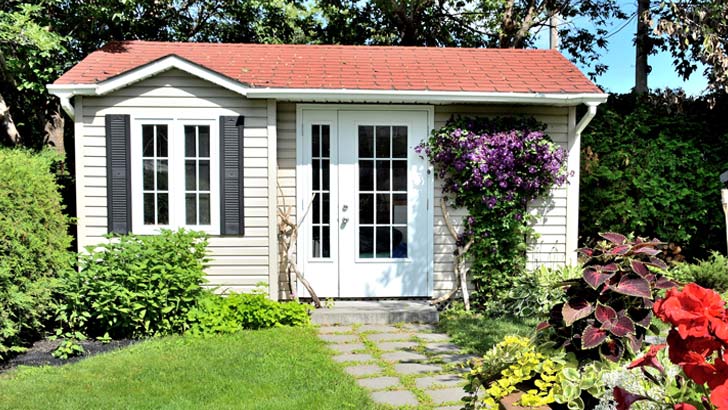Should you build a granny flat to boost your income?
By Pam Walkley
Building a granny flat or studio (self-contained accommodation) in your backyard could well boost your income and help solve our housing crisis at the same time.
We have the capacity to build more than 655,000 granny flats across Australia's three largest capitals, according to a recent report on the greatest opportunities for development.
The study, by the national town planning research platform Archistar, real estate construction lender Blackfort, and property data and analytics provider CoreLogic, assessed every residential block across Sydney, Melbourne and Brisbane to determine how many properties have the building potential for a self-contained two-bedroom unit.
Sydney has the most granny flat opportunities, with around 242,000 suitable properties, representing 17.6% of the metro region's housing stock. Melbourne has almost 230,000 potential sites, representing 13.2% of stock, while Brisbane has almost 185,000 suitable sites, representing 23.3% of houses across the metro region.
Of the sites identified, more than a third (36%) are within two kilometres of a train or light rail station and 17% have a hospital within the suburb boundary.
Untapped potential
CoreLogic research director Tim Lawless says the results highlight significant untapped development potential, which could go some way toward fast-tracking a partial remedy to the housing shortage in the country's largest cities.
"For policymakers and government, granny flats present an immediate and cost-effective opportunity to deliver much needed housing supply within existing town planning guidelines.
"For homeowners, the addition of a second self-contained dwelling is an opportunity to provide rental housing or additional accommodation for family members, while at the same time increasing the value of their property and potentially attaining additional rental income."
The downsides of building a granny flat
Adding a granny flat or second dwelling to your property is not all upside. You need to ask yourself if you are overcapitalising your property, because the cost to develop a granny flat will not always result in a similar rise in the value of your property.
"You will not be gaining the same instant equity as you could gain from other dual-occupancy property developments. In fact, it's common for lenders to not value the property much higher - if at all - than the cost to build," says Lloyd Edge, founder and director of Aus Property Professionals buyers agency.
Another problem is that not everyone wants a tenant in their backyard, so when it comes to sell there will be fewer buyers, which may lessen the demand and even the amount buyers are prepared to offer.
If you are living in the main home on the property, it can also lessen your amenity by, for example, depriving you of putting in a pool or having a bigger garden or play area for children.
Not suitable for all investors
Granny flats are not suitable for all investors and it will entirely depend on your investment strategy, says Edge. "If you are looking for long-term capital growth - the real cornerstone for wealth creation - then a granny flat will not guarantee this for you.
"However, if your strategy is focused on achieving higher cashflow and rental yield, then a granny-flat strategy may be the right choice for you.
"For a cashflow strategy, a granny flat will add additional cashflow and increase the yield of your investment property, which in turn is likely to assist your serviceability from a lender's perspective, but at the cost of long-term capital growth."
Granny flats generally punch above their weight when it comes to rental returns. For example, a $160,000 build can attract a rent of $500 a week in some areas, especially in the current undersupplied rental market.
This amounts to $26,000 a year, meaning the outlay on your granny flat is recouped in just over six years, not accounting for any other costs, such as interest on borrowings or maintenance.

Benefit from tax deductions
Another strategy suitable for granny flat development is a tax-focused one. For high-income earners with a focus on tax reduction, a granny flat may provide some benefits, such as additional depreciation, capital deductions and interest expenses.
"While you can't claim depreciation deductions on your owner-occupied property, you can depreciate your granny flat if it is an income-producing asset," says Tyron Hyde, director of quantity surveyors Washington Brown. "Items like appliances, carpet, hot water units and air-conditioning can all be depreciated at the same rate as an investment property."
A typical granny flat costing $100,000 could produce a depreciation claim of $7100 in the first year, comprising $5000 for plant and equipment and $2100 for capital works, according to a depreciation schedule prepared by Washington Brown. Over five years the claims could amount to $22,900 - almost a quarter of the construction cost.
For a $200,000 granny flat, the first-year deduction is estimated as $12,300 ($7900 plant and equipment and $4400 capital works) and $38,500 over five years.
Granny flat planning laws
Certainly, it has become progressively easier to have a granny flat in your backyard, with Victoria being the latest State to announce sweeping changes to restrictive planning codes - no permit needed to build a granny flat or second small home of less than 60sqm - and you need a block of at least 450sqm.
Most other states also have systems in place for hassle-free approvals for granny flats, but it's always wise to check with your local council before going ahead.
Granny flats are also reasonably cheap to build. Costs range from about $30,000 for a DIY flat pack to more than $200,000 for a custom-built apartment, which includes surveying, planning, engineering, materials, labour and trades.
Finding a builder, however, is not so easy, as demand for their services outstrips supply, especially as there have been several building company collapses recently.
Do the groundwork first. Get several quotes and ask to view a builder's work. Finally, be sure to check a builder's viability before signing any contracts.
Extra income can slash home loan interest
If you put all the rental from a granny flat towards the mortgage on your home, it can save you a lot of interest and enable you to pay off the loan faster, according to granny-flat information website diygrannyflat.com.au.
If, say, your home loan is $700,000 and you use the $500 rent from your granny flat to boost your mortgage payments, you can save $306,000 in interest and reduce your loan by 16 years.
How to cover the costs
There are several ways you can finance a granny flat, according to the financial comparison site Canstar.
They include drawing on your savings, using the redraw/offset facility linked to your home loan, refinancing your home loan, if you have sufficient equity or taking out a personal loan.
As you can claim the interest on borrowings for an investment property, arrange a separate loan for your granny flat if you intend to rent it out.
Also keep in mind that if you do earn income on renting out a granny flat in your family home's backyard, you will likely forfeit the capital gains tax exemption on the primary residence.
Get stories like this in our newsletters.



